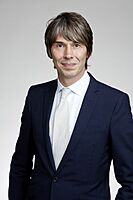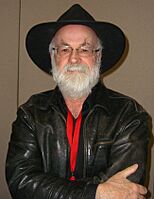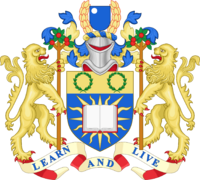Open University facts for kids
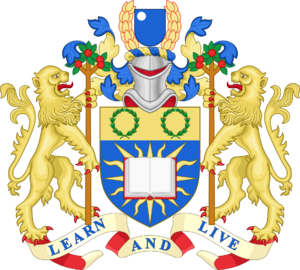
Coat of Arms of The Open University
|
|||||||||||||||
| Motto | Learn and Live | ||||||||||||||
|---|---|---|---|---|---|---|---|---|---|---|---|---|---|---|---|
| Type | Public, distance education university | ||||||||||||||
| Established | 1969 | ||||||||||||||
| Founders | Harold Wilson Jennie Lee Walter Perry Peter Venables |
||||||||||||||
| Budget | £474.1 million (2019–20) | ||||||||||||||
| Chancellor | Baroness Lane-Fox of Soho | ||||||||||||||
| Vice-Chancellor | David Phoenix | ||||||||||||||
| Students | 199,400 (2023) | ||||||||||||||
| Undergraduates | 146,424 (2022) | ||||||||||||||
| Postgraduates | 11,379 (2022) | ||||||||||||||
| Location |
,
United Kingdom
|
||||||||||||||
| Campus | Rural | ||||||||||||||
| Colours |
|
||||||||||||||
| Affiliations | EUA University Alliance Association of Commonwealth Universities Middle States Association of Colleges and Schools Universities UK |
||||||||||||||
The Open University (OU) is a special kind of university in the United Kingdom. It's the biggest university there by the number of students. Most students learn from home, not on a campus. Many courses can be studied from anywhere in the world.
The OU was started in 1969. It first used old TV studios in London. The first students began learning in 1971. Today, the main offices are in Milton Keynes. The university offers many different types of qualifications. These include degrees, diplomas, and certificates. You can even create your own degree by choosing different subjects.
The Open University has about 200,000 students. This makes it one of the largest universities in Europe. Over 2.3 million people have studied with the OU since it began. It's also one of only two UK universities recognized in the United States. Many successful people have studied or taught at the OU. These include former UK Prime Minister Gordon Brown.
Contents
History of The Open University
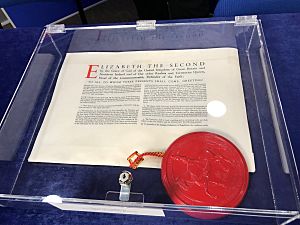
The Open University was created by the Labour government. This was led by Prime Minister Harold Wilson. He really believed in the idea of a university for everyone.
Planning for the OU started in 1965. Jennie Lee was in charge of education at the time. She wanted the OU to offer high-quality learning to more people. She set up a group to plan how it would work. This group included university leaders and TV broadcasters.
The BBC helped a lot with the idea of using television. They helped make it possible to broadcast teaching programs.
Prime Minister Wilson saw the OU as a way to make British society more modern. He thought it would help the economy. It would also give more people a chance to get a good education. Using TV and radio for courses was a new idea.
At first, many people didn't think the OU would work. Some government officials and even other politicians were against it. But Jennie Lee was very determined. She had strong support from Wilson. Also, the first cost estimates seemed very low.
By the time the real, higher costs were known, it was too late to stop. The university officially received its special permission, called a royal charter, on April 23, 1969.
How The Open University Works
Staff and Support
Most of the people who teach at the OU are part-time tutors. They are called "associate lecturers." In 2021–22, almost 5,000 people worked as tutors. There are also many full-time teachers and researchers. They create the learning materials. Other staff help with administration and support. The OU was even named one of the 'Best Places to Work' in the public sector.
Learning Areas
The university has different main learning areas, called faculties. These include:
- Arts & Social Sciences
- Business and Law
- Science, Technology, Engineering and Mathematics (STEM)
- Wellbeing, Education and Language Studies (WELS)
The Open University also has a Business School. It was started in 1988. This school offers an MBA program, which is a Master of Business Administration. The Business School is recognized by important international groups.
How Students Learn
Teaching Methods
The OU uses many ways to teach students. These include books, audio materials, and the internet. They also used to have TV programs on the BBC. These TV programs stopped in 2006. Now, they focus more on online learning.
Students get help from tutors. These tutors give feedback on their work. They can be reached by phone or online. Some short courses don't have a tutor. Instead, they have online forums where students can get help.
Some courses have required "day schools." These are short, in-person sessions. Some courses also have "summer schools." These are week-long events where students can focus on their studies. However, many courses can be completed entirely from home.
The OU used to make many TV and radio shows. These shows helped bring learning to a wider audience. Now, they focus more on online resources. In 2004, they stopped their late-night BBC Two programs. They now make more semi-academic TV shows for channels like BBC Four.
In 2006, the OU started OpenLearn. This website offers many free learning materials. You can download and even change these materials for teaching.
The OU also uses virtual worlds for teaching. They have islands in a virtual world called Second Life. They also offer many free online courses through a platform called FutureLearn. This platform started in 2013.
How Students are Graded
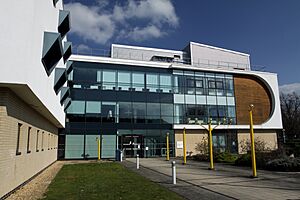
OU courses are usually graded using both exams and coursework. Coursework often includes assignments that tutors mark. It can also include online quizzes. The final part is usually an exam or a big final assignment.
Results are given as grades from 1 to 4. Grade 1 is the highest (like a distinction). Grade 4 is a pass. If you get below 40%, it's a fail. These grades help decide your final degree classification.
What You Can Study
Undergraduate Degrees
OU courses are worth "credits." Most courses are 30 or 60 credits. A full-time student usually studies 120 credits per year. An undergraduate degree needs 300 or 360 credits.
Students usually take about six years to finish a degree. This is because they often study part-time. The OU offers many types of undergraduate degrees. These include Bachelor of Arts (BA), Science (BSc), Laws (LLB), and Engineering (BEng). You can choose a specific subject or create your own "Open" degree.
Many OU departments now offer short, 10-credit courses. These are usually online and start often. They give a quick introduction to a subject. Some science courses need a short residential session. This is for hands-on lab experience.
Most courses run from October to June. Some also run from February to October. You'll have several assignments during the year. Most courses also have a final exam or major project.
Open Degree
The "Open" degree is very popular. It lets students choose courses from many different subjects. This helps them create a degree that fits their interests or job goals. It can be a Bachelor of Arts Open or a Bachelor of Science Open.
The Open degree is the most popular qualification at the OU. About 20,000 students are studying for an Open degree. Over 236,000 people have graduated with an Open degree since the OU started.
Other Qualifications
The Open University also offers other qualifications. These include:
- Certificates: Usually after 120 credits.
- Diplomas: After 240 credits.
- Foundation degrees.
Postgraduate Degrees
The Open University also offers higher-level degrees. These include:
- PhD (Doctorate): For advanced research.
- Master's degrees: Like MBA, MSc, MA, and MEd.
- Postgraduate diplomas and certificates.
These higher degrees help people become experts in their field.
Graduation Ceremonies
The Open University holds special ceremonies for its graduates. These are called "Presentation of Graduates." Students who have earned their degrees are presented to the University Chancellor.
These ceremonies happen throughout the year. They are held in different cities across the UK and Ireland. They are formal events with special robes and traditions.
Academic Dress
The special robes worn at OU graduation ceremonies are blue and gold.
| Degree | Gown | Hood |
|---|---|---|
| Doctor of Education | Royal blue, 3-inch gold facings | Full shape, gold Panama, lined light blue |
| Doctor of Letters | Royal blue, 5-inch gold facings | Full shape, gold, lined royal blue |
| Doctor of Philosophy | Royal blue, 3-inch gold facings | Full shape, royal blue, lined gold, edged 1-inch gold |
| Doctor of Science | Royal blue, 5-inch gold facings | Full shape, gold, lined light blue |
| Master of Philosophy | Light blue | Full shape, light blue, edged gold |
| Master of Research | Light blue | Simple shape, royal blue, faced 3-inch golf |
| Master of Science | Light blue | Full shape, dark blue, lined gold, edged 1/2-inch gold |
| Master of Arts | Light blue | Full shape, dark blue, lined gold, edged 1/2-inch gold |
| Master of Business Administration | Light blue | Full shape, dark blue, lined gold with a blue edge, edged 1-inch gold |
| Master of Education | Light blue | Full shape, dark blue, lined gold with a 1-inch white edge on a cowl, edged 3/8-inch gold on cape |
| Master of Engineering
Master of Mathematics |
Light blue | Full shape, gold, faced 3-inch inside light blue |
| Bachelor of Arts
Bachelor of Science Bachelor of Engineering Bachelor of Laws |
Dark blue | Simple shape, light blue, faced 3-inch gold |
| Foundation degree | Dark blue | Simple shape, light blue, faced 3-inch dark blue |
In 2000, the Open University was the first in the UK to have an online graduation ceremony. Students from eight countries received their degrees online. Tim Berners-Lee, who invented the World Wide Web, also received an honorary degree.
University Rankings and Research
| University rankings | |
|---|---|
| Global – Overall | |
| ARWU World | 601-700 (2022) |
| THE World | 601-800 (2024) |
| USNWR Global | 718 (2021) |
| Regional – Overall | |
| USNWR Europe | 308 (2022) |
| National – Overall | |
| ARWU National | 42-49 (2022) |
| CWUR National | 51 (2022) |
| USNWR National | 51 (2021) |
| TEF England | Gold (2023) |
The Open University is listed in major world university rankings. These include the Times Higher Education World University Rankings.
The OU also does a lot of important research. Its Planetary and Space Sciences Research Institute is very famous. They have been involved in space missions. For example, they helped with the Cassini-Huygens mission to Saturn. A team from the OU built an instrument that landed on Saturn's moon Titan.
The OU has over 500 people doing research in many different areas. They spend about £20 million each year on research.
Space Observatories
The university has telescopes and other instruments in Tenerife, Spain. These are at the Teide Observatory. They have special telescopes that can be controlled remotely.
About OU Students
In the 2021/22 school year, there were over 208,000 students. Most students are from England, Scotland, Wales, and Northern Ireland. Many also come from other European countries. More women than men study at the undergraduate level.
While many students are adults, more and more young people are joining the OU. In 2010/11, the OU had more students aged 17-25 than any other UK university. Many of these younger students also work full-time. The youngest OU graduate was a 15-year-old boy who earned a science degree in 2014.
Course Choices
OU students sign up for individual courses, called modules. These modules are then put together to form a degree.
In 2009/10, social studies was the most popular subject. Science and history were also very popular. Even smaller programs, like creative arts, had many students.
The most popular course in 2009/10 was "An introduction to the social sciences."
Fees and Help with Costs
Many students get financial help for their studies. In 2015/16, over 17,000 students received help. The cost of a degree changed in 2012. This was because the government reduced its funding. Now, students in England pay more than students in other parts of the UK. The main way the OU gets money is from student fees.
Student Numbers and Achievements
The number of students at the OU grew quickly. It went from under 50,000 in 1970/71 to over 250,000 in 2009/10. However, numbers dropped when the fees changed.
By 2009/10, over 1.5 million students had studied at the OU. More than 800,000 qualifications had been awarded.
The Open University also helps other colleges give out qualifications.
Student Association
The Open University Students Association is like a student union. It helps OU students. It's a charity funded by the OU. Students can meet up, volunteer, and find information. They can also join clubs and societies, just like at other universities.
Famous People Connected to The Open University
-
Jocelyn Bell Burnell led the physics department at the OU for 10 years.
-
Colin Pillinger was a founding member of the Planetary and Space Sciences Research Institute at OU.
-
Stuart Hall was a professor of sociology at the OU for 18 years until his retirement in 1997.
Many well-known people have taught or studied at the Open University. Some famous academics include:
- Jocelyn Bell Burnell – a famous astronomer
- Colin Pillinger – a planetary scientist
- Stuart Hall – a social scientist
Graduates and Alumni
-
Former Home Secretary and Minister Lord Reid is an Open University alumnus.
-
While acting in London, Talulah Riley received a degree in Natural Sciences from the OU.
-
Meles Zenawi – former President and Prime Minister of Ethiopia. Meles acquired an MBA from the OU in 1995.
-
Natalya Kaspersky earned a bachelor's degree from OU.
-
Sir Lenny Henry graduated with a BA Hons in English Literature, from the OU.
-
Marat Khusnullin – Deputy Prime Minister of Russia graduated from the OU with a degree in management.
-
Chris Whitty, Chief Medical Officer for England, completed a graduate diploma in economics at the Open University.
-
Romola Garai obtained a degree in English literature from the Open University.
Many famous people have graduated from the OU. These include:
- Talulah Riley – an actress
- Meles Zenawi – former Prime Minister of Ethiopia
- Sir Lenny Henry – a comedian and actor
- Chris Whitty – Chief Medical Officer for England
Honorary Graduates
-
Former UK Prime Minister and OU tutor Gordon Brown received an honorary doctorate from the Open University.
-
Honorary graduate and OU supporter Sir David Attenborough
-
Tim Berners-Lee – inventor of the World Wide Web and recipient of OU honorary doctorate.
-
King Charles III (then Prince Charles) received an Honorary Degree from the OU in 1982.
-
Brian Cox was awarded an honorary doctorate by the OU.
-
In 2013 the Open University honoured Terry Pratchett with an honorary doctorate.
-
Richard Dawkins holds an honorary doctorate from the Open University.
The OU also gives honorary degrees to important people. These include:
- Gordon Brown – former UK Prime Minister
- Sir David Attenborough – a famous naturalist
- Tim Berners-Lee – inventor of the World Wide Web
- King Charles III – received an honorary degree in 1982
- Brian Cox – a physicist and TV presenter
- Terry Pratchett – a well-known author
The OU in Stories
The Open University has appeared in many films and TV shows.
- In the film Educating Rita, a working-class character studies English literature with the OU.
- TV characters like Anne Bryce in Ever Decreasing Circles and Yvonne Sparrow in Goodnight Sweetheart also took OU courses.
- In Keeping up Appearances, the character Onslow sometimes watches OU programs on TV.
- In 2006, Lenny Henry wrote and starred in a BBC drama called Slings and Arrows. It was about someone who falls in love while taking an OU English Literature course. (Lenny Henry himself earned an OU degree in English).
- In the TV series Life on Mars, a character gets messages from the real world through OU programs.
- Dorian Green from Birds of a Feather started studying psychology with the OU.
- In the novel The Bone Clocks, a character studies psychology at the Open University.
- In the novel Swing Time, the narrator's mother is an OU student.
- In the Bottom episode Accident, characters fall asleep watching an OU lecture.
Partnerships
Armed Forces
The OU has an agreement with the UK military. This allows members of the British armed forces to take many courses. They can study even when they are on active duty.
Partner Institutions
The Open University works with many other schools around the world. These partner schools can offer degrees that are approved by the OU. This means the degrees are recognized as Open University qualifications.
Research Partnerships
The OU also works with other universities on research.
- The Grand Union: This is a partnership with the University of Oxford and Brunel University London. They work together to train researchers.
- Open-Oxford-Cambridge AHRC Doctoral Training: This partnership with the University of Oxford and University of Cambridge helps fund students studying arts and humanities.
- Imperial-Cambridge-Open Centre for Doctoral Training: From 2014 to 2022, the OU worked with Imperial College London and the University of Cambridge. They trained students in civil nuclear energy.
Coat of Arms
The Open University has its own special symbol, called a Coat of Arms. It features an open book and laurel wreaths. The motto is Learn and Live.
|
See also
 In Spanish: The Open University para niños
In Spanish: The Open University para niños


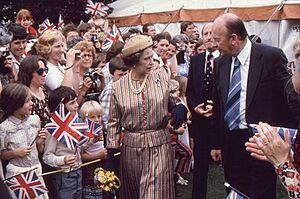
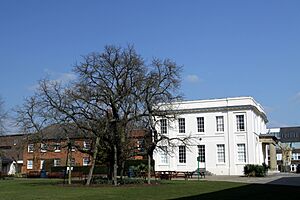

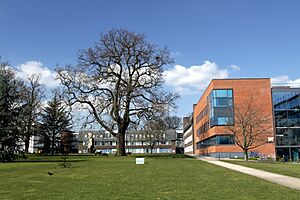

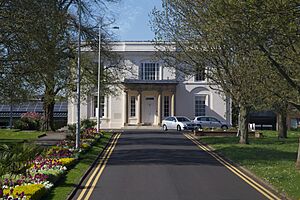
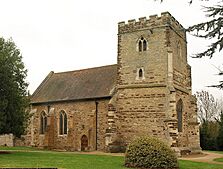
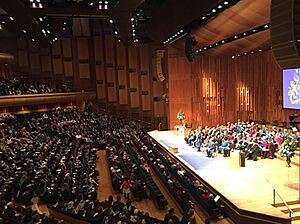
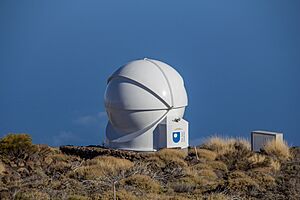
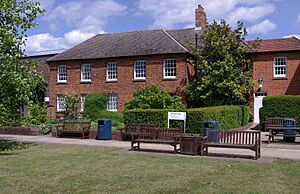
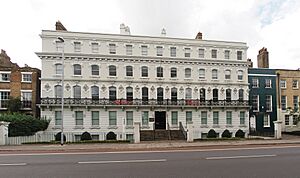
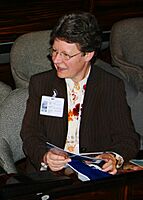
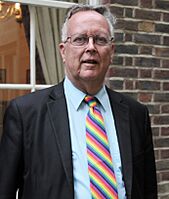
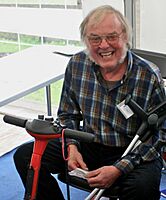
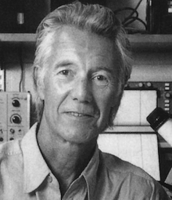
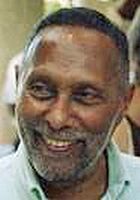
![Former Home Secretary and Minister Lord Reid is an Open University alumnus.[69]](/images/thumb/c/cc/Official_portrait_of_Lord_Reid_of_Cardowan%2C_2020.jpg/150px-Official_portrait_of_Lord_Reid_of_Cardowan%2C_2020.jpg)
![While acting in London, Talulah Riley received a degree in Natural Sciences from the OU.[69]](/images/thumb/0/07/TalulahRileyAug09_%28cropped%29.jpg/180px-TalulahRileyAug09_%28cropped%29.jpg)
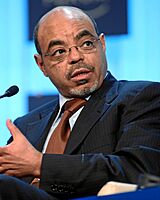
![Natalya Kaspersky earned a bachelor's degree from OU.[75]](/images/thumb/4/40/Natalya_Kaspersky_crop.jpg/127px-Natalya_Kaspersky_crop.jpg)
![Sir Lenny Henry graduated with a BA Hons in English Literature, from the OU.[78]](/images/thumb/c/c9/Lenny_Henry_in_The_Comedy_of_Errors_2011_%28crop%29.jpg/153px-Lenny_Henry_in_The_Comedy_of_Errors_2011_%28crop%29.jpg)
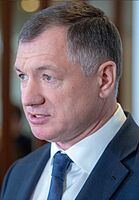


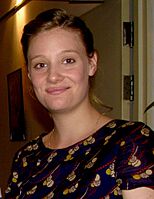
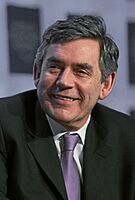
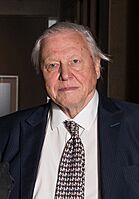
![Tim Berners-Lee – inventor of the World Wide Web and recipient of OU honorary doctorate.[76][77]](/images/thumb/c/c2/Tim_Berners-Lee_2012.jpg/180px-Tim_Berners-Lee_2012.jpg)
![King Charles III (then Prince Charles) received an Honorary Degree from the OU in 1982.[70][71]](/images/thumb/7/71/Prince_Charles_2012.jpg/147px-Prince_Charles_2012.jpg)
